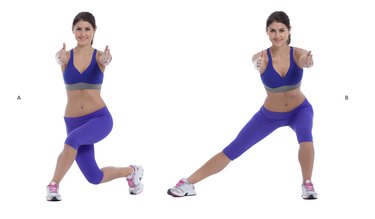
A clean diet helps when you're trying to build muscle and lose fat on your backside. Eating clean means avoiding certain foods that aren't going to help you reach a more toned butt -- and might actually encourage your body to store additional fat there. Instead of only focusing on what you can't eat, emphasize and celebrate all the tasty, healthy foods you can include as part of a butt-toning diet.
Strategy for a Toned Butt
Video of the Day
Your diet alone will never give you the buttocks you want without targeted resistance training. When trying to increase the tone and tightness of your buttocks, you must have a regular strength-training routine that includes moves such as squats, lunges, step-ups and donkey kicks -- which have you on all fours and pressing one leg up toward the ceiling. Do these exercises at least two times per week on nonconsecutive days.
Video of the Day
But if you strength-train without changing your diet, you're likely not to see results either. Losing excess fat in the derriere requires you cut calories so you consume fewer than what you burn in a day; there's no need to starve, however. For most people, a 250- to 500-calorie deficit combined with resistance training yields fat loss without a lot of muscle loss.
Processed Foods
Junky processed foods, including chips, crackers, snack mixes, cereal bars and most packaged bread, deter your buttock-toning process. These foods are high in calories and low in nutrition, especially protein, a key muscle-building nutrient. They can easily trigger overeating, so you don't get enough of the foods you do need, such as chicken, fish, lean beef and fresh vegetables. The fresh, whole-food options help your body build muscle and lose weight. Processed foods tend to do the opposite and promote weight gain. Reach for quality snacks instead that come from whole foods, such as cottage cheese with raisins, plain yogurt with fresh berries, low-fat cheese with an apple or a handful of almonds.
Added Processed Sugar
Sugar is naturally found in milk and fruit, for example, but doesn't need to be added to any foods. Sugar also offers no nutrients but does pad your diet with excess calories that defeat your goals to build a more toned bum. Read ingredient lists; foods that have sucrose, fructose, dextrose or corn syrup should be avoided. This even means fruit-flavored yogurts and "healthy" energy bars. When you need something sweet, reach for whole foods with natural sweetness. Berries, apples and plain yogurt are all options. Avoid artificially sweetened foods in an attempt to sneak in a sweet without the calories. In 2010, a paper in the Yale Journal of Biology and Medicine showed that artificial sweeteners may actually promote weight gain, rather than weight loss and muscle development.
Calorie-Filled Drinks
A way to ingest too much sugar and too many calories without even realizing it is by consuming calorie-laden drinks, such as juice, soda and fancy coffees. Your body doesn't register the drinks as satiating, despite that you may have loaded up on a significant amount of calories and sugar with minimal nutrition. The one exception to the no-calorie drink rule is a post-workout smoothie that includes 20 to 30 grams of protein in the form of whey protein powder. Make this smoothie with milk or water and a handful of berries for more flavor, and have it within 30 to 60 minutes of completing your workout. Whey protein enhances muscle growth and expedites repair of worked fibers. At other times, drink water or unsweetened herbal teas.
- Muscle and Fitness: 7 Ways to Burn Fat Without Losing Muscle
- Oxygen Women's Fitness: Sculpt a Better Butt
- American Council on Exercise: Glutes to the Max
- The Female Body Breakthrough: The Revolutionary Strength-Training Plan ...; Rachel Cosgrove
- Yale Journal of Biology and Medicine: Gain Weight by “Going Diet?” Artificial Sweeteners and the Neurobiology of Sugar Cravings
- The Washington Post: Those Liquid Calories
- Journal of the American College of Nutrition: Whey Protein Supplementation During Resistance Training Augments Lean Body Mass